Although the American Coot is almost exclusively an herbivore it will occasionally make an exception and eat animal matter. They’re also well-known for food thievery (kleptoparasitism) and two days ago this Pied-billed Grebe nearly became one of its victims.
These images are of documentary quality only.
The grebe had captured a fish (yes, another weather loach – more about that later) and at first it was able to concentrate on its preparations for swallowing the fish.
But almost immediately this coot moved in aggressively. And as fast as it could swim. The grebe is already aware that there may be a developing problem.
For this little grebe to swim at this angle its feet (which are attached very far back on the body) have to really be churning. The coot was a faster swimmer than the grebe (especially with the added load of the fish) and closed the distance between them quickly. First the grebe zigged to my right…
and then abruptly changed direction and came right at me. The coot is still closing in.
When this little drama began I didn’t know if the coot was simply acting aggressively toward the grebe or if it was actually after the fish (all this happened very fast) but when I reviewed my images it seemed obvious that the fish was its goal. In this shot, for example, the eye of the coot seems to be directly on the fish. And this behavior began immediately after the grebe surfaced with the loach.
To be perfectly honest, in all the excitement I can’t remember how the grebe escaped with the fish, but it did. It may have dived with it or the coot may have simply given up and in reviewing my images I can’t be sure what happened. When I’m looking through my lens my “peripheral vision” is virtually nonexistent.
But I can tell you that the grebe was in an incredible hurry to swallow the fish before it was challenged again. All the frantic neck-pumping and other efforts required to get the fish down quickly created quite the commotion in and above the water.
Ok, back to the occasional carnivorous habits of coots. As I said earlier, coots are almost exclusively herbivores but they’ll occasionally eat invertebrates and smaller vertebrates – especially during the breeding season. They’ve also been documented to consume carrion. This image was taken last winter when a few “nature” photographers were baiting eagles in close for better images. From my position I could see this hunk of “meat” buried in the phragmites but couldn’t positively identify it, though others reported later that it was a chicken carcass (I avoided the area after learning that piece of disturbing news). Here you can see the center coot with a hunk of meat in its beak.
One more interesting observation. I’ve been photographing at this pond for seven years and prior to this year none of the fish I’ve seen consumed by birds has been a weather loach (though I have seen loaches eaten in other nearby areas). So far this winter I’ve seen roughly a dozen fish eaten here by grebes and I’m quite sure that all but one of them was a loach. That tells me that this pond is infested with this invasive species. Last week I reported some of these observations to both state and federal fisheries specialists but I’ve yet to hear back from either one of them.
Ron


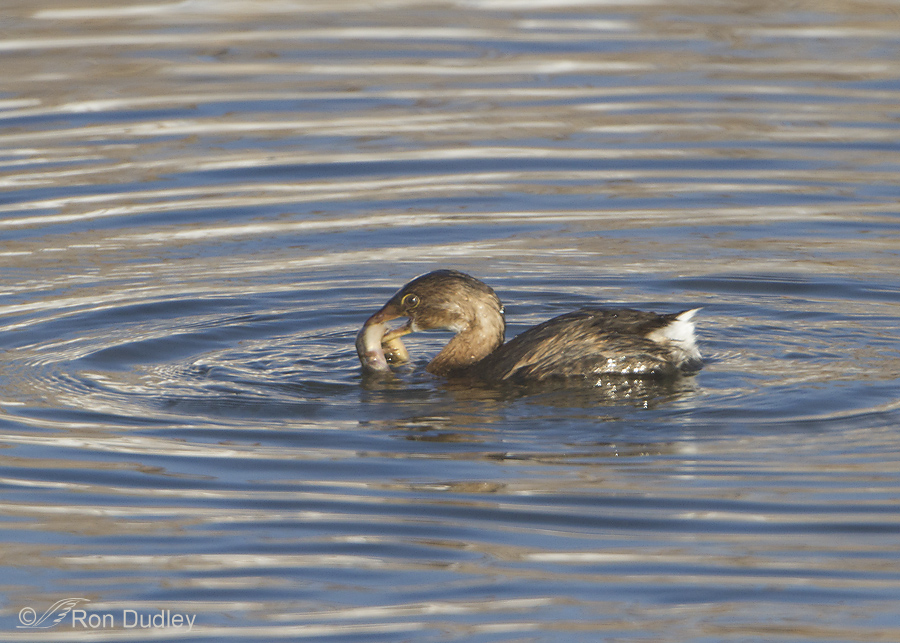
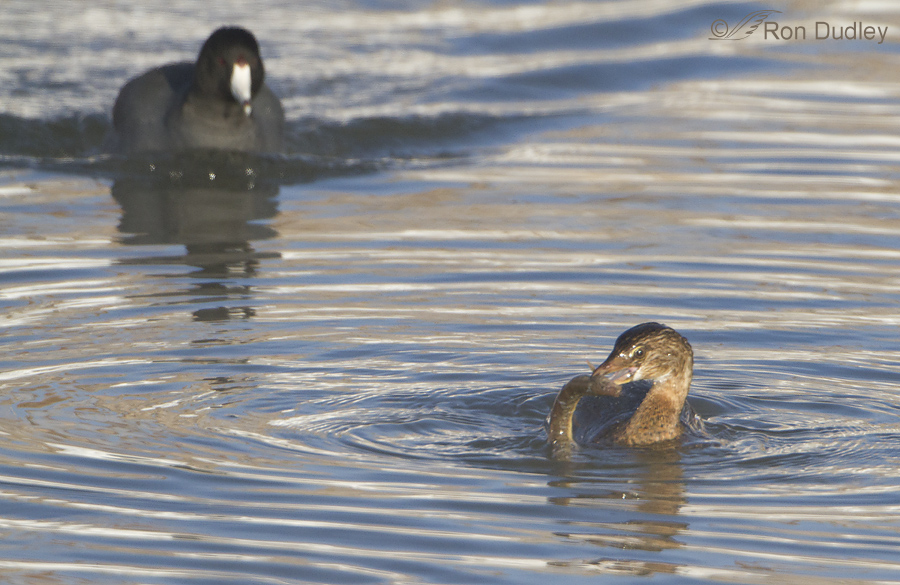
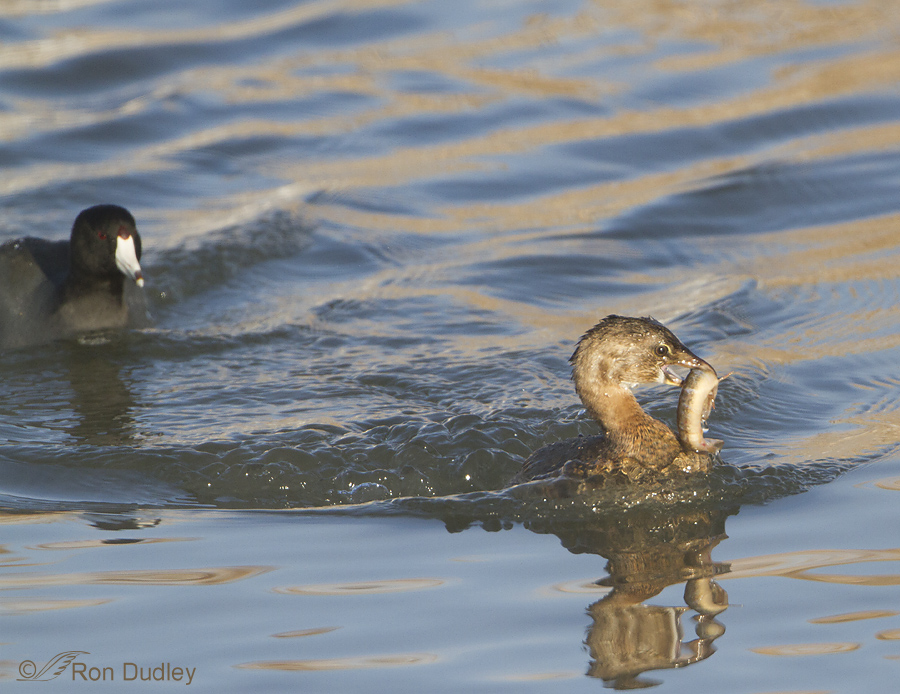
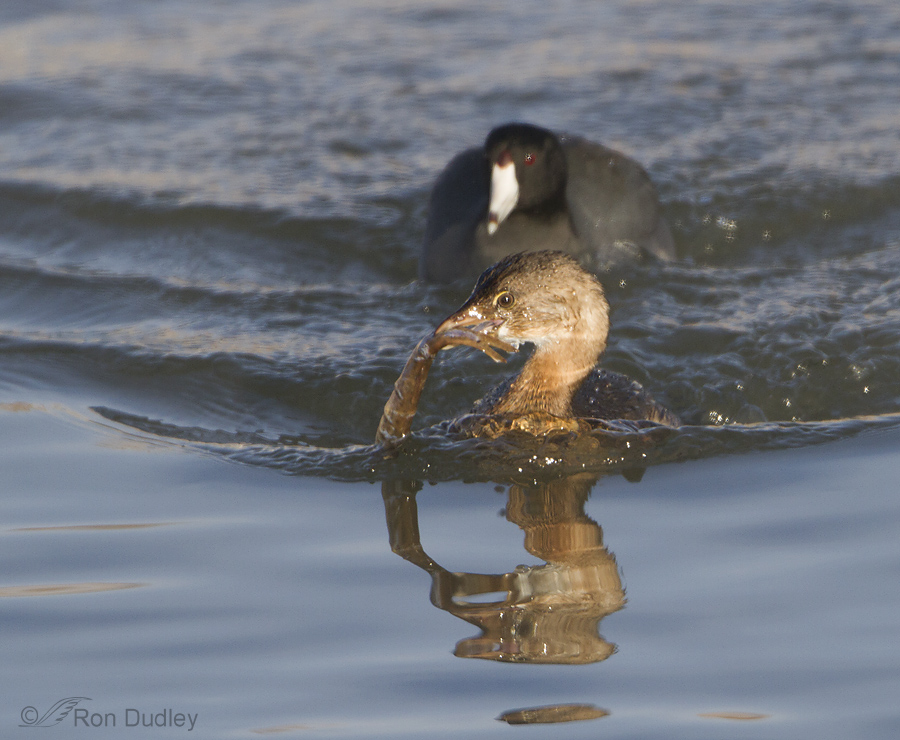
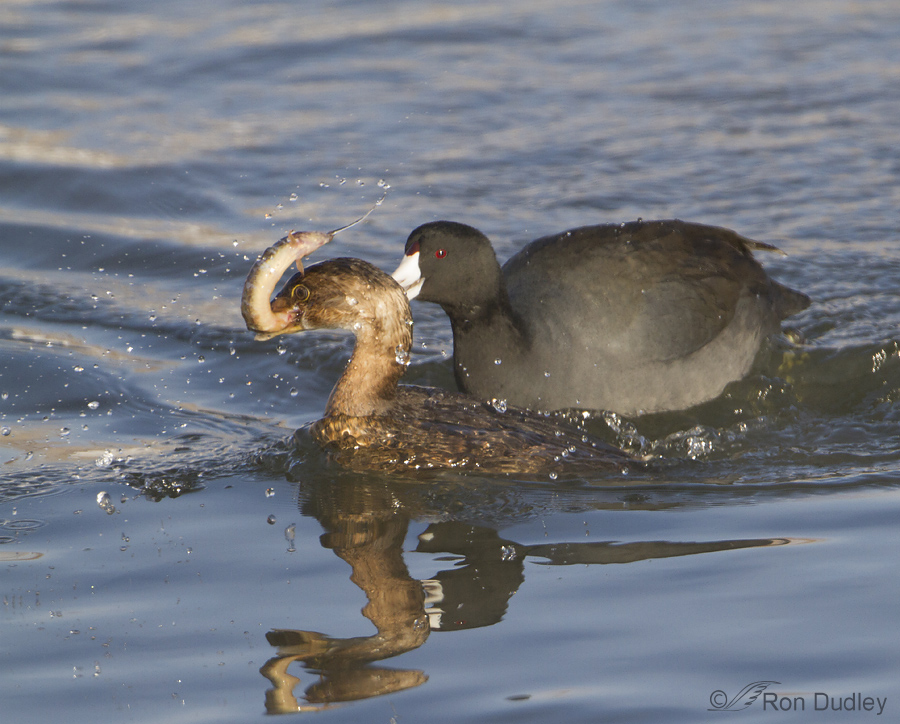
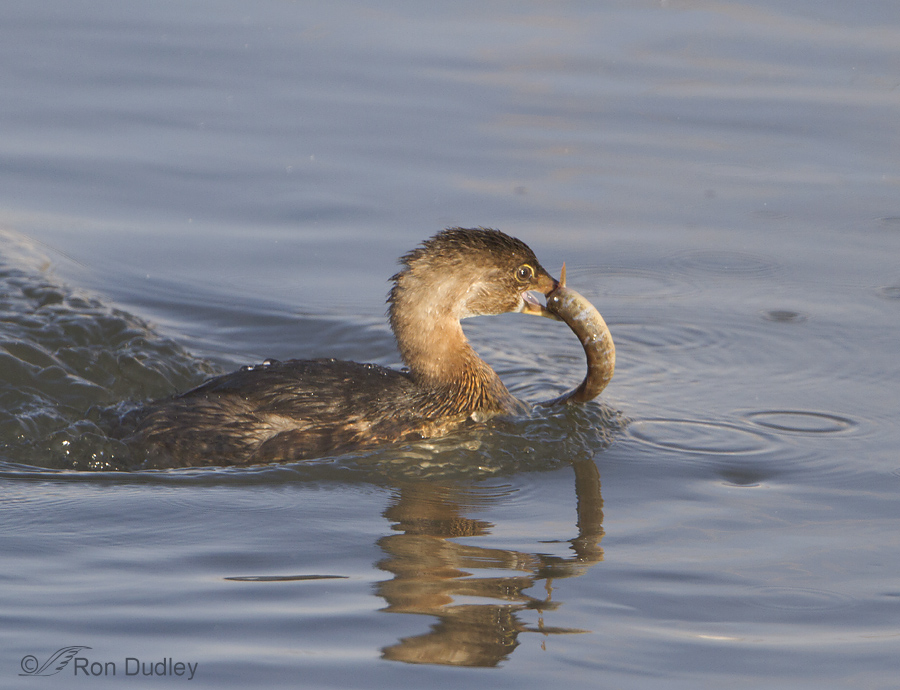
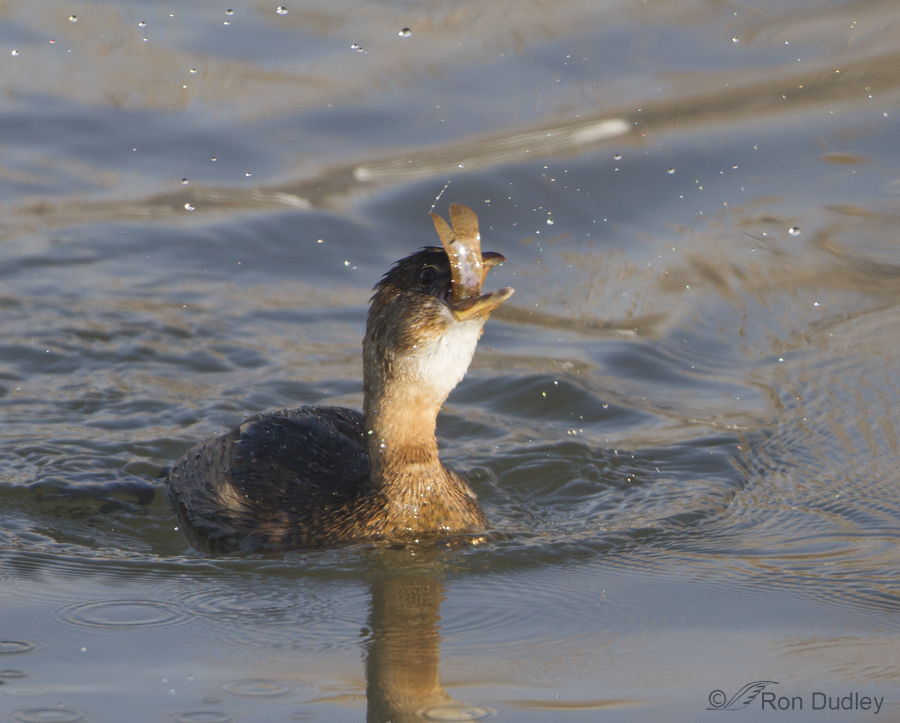
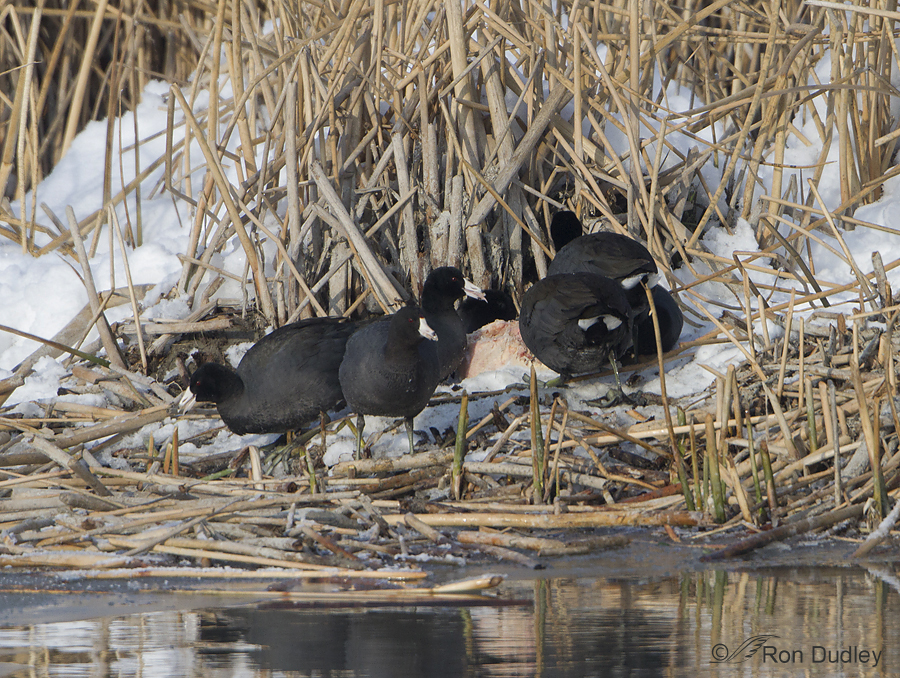
Ron finally heard from “the authorities” and this is what they told him, “We’ve never seen a weather loach. We never HOPE to see one..but, this we’ll tell you anyway, we’d rather see than be one!”
YO! Anytime any of us feel things are getting a little tough, all we have to do is imagine being a Grebe and having to swallow a weather loach to survive….YUK!!!
Great series, Ron! I’ve know about Coots occasionally be carnivorous but haven’t been able to get an image to demonstrate it. Your Coot was obviously after a fish sandwich!
Very sorry to hear about so-called photographers baiting for eagles. 🙁
A fascinating series Ron. And my anthromorphic self is pleased that the grebe kept the loach.
Thank you, Elephant’s Child.
I had a similar experience with our DEC when I reported a family of Mexican Gray squirrels in our area. There is no mistaking the difference between these and our usual Easter Grays. The Mexican grays are slightly bigger, much redder (a rich, intense sienna), and have longer heads, longer ears. Eastern grays have shorter, rounder heads and rounder ears. They tended to intimidate the eastern grays away from feeding areas. I’ve raised grays and know the difference. I felt it was important to report them as they can be very damaging to fruit crops. Florida has tried to get rid of them, destroying their dreys(nests) whenever possible. When I finally got a response, the woman who contacted me, was more interested in “patiently” explaining to me why they “couldn’t be anything other than a color phase” of the eastern gray “, than listening to anything I had to say. When I sent them pictures and told them that they had also been sighted in another, more northern part of the county, I never heard from them again. Makes you wonder…and turns you off! Fortunately, we haven’t seen them since fall of 2012…maybe the cold winter was too much for them…or maybe they’re in another yard……
Your situation with the squirrels and the DEC sounds frustrating, Patty. I know the feeling…
That was an incredible story. That gerbe was focused. Oce again that fish was almost as big as he/she was. I could hear and ‘Jaws’ music playing at the coot approached. Great story in pictures. Always a learning experience. Why don’t you think you’ve been contacted by the authorities about those ugly loaches?
I can only guess why I haven’t been contacted by the authorities, Ellen and some of the possibilities aren’t very flattering to them.
I know the feeling!
Wonderful series of photos, and I’m glad the grebe won! The only positive I can see in the invasive fish is that it apparently is doing a good job of feeding the grebes…
That’s the only positive I’m aware of too, Susan. That and the fact that its presence is providing me some interesting photos.
Great series Ron, many thanks for the documentary.
You’re very welcome, Dick. Thank you.
Ron, you really captured the anxiety of the grebe holding onto and eventually gobbling the loach. Thanks. Good thing that grebes apparently do not get ruptured GI tracts like people can.
“anxiety of the grebe” describes it perfectly, Diana. This bird was frantic in its efforts to get the fish down quickly.
Very interesting! I had no idea that the coots ate meat since I’ve never seen it. As far as not hearing back from authorities on the loaches, I’m not surprised. I just think that they don’t know what to do about these invasive fish. A similar situation exists with the flying carp in the Mississippi River. Is it impossible to get rid of these invasives or do they just know how.
Charlotte
I don’t know if it’s possible or not, Charlotte. I’m sure it would be extremely difficult. But I do know that I’m disappointed that I haven’t heard back from the “authorities”. If they want input like this from the public they should encourage it rather than discourage it…